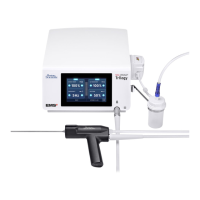Portable and mobile RF communications equipment should be used no closer to any part of the SWISS LITHOCLAST®
TRILOGY, including cables, than the recommended separation distance calculated from the equation applicable to
the frequency of the transmitter.
Conducted RF
IEC 61000-4-6
Radiated RF
IEC 61000-4-3
3 Vrms
150 kHz –
80 MHz
3 V/m
80 MHz –
2.5 GHz
10 Vrms
10 V/m
Recommended separation distance
d = 0.35 √P
d = 0.35 √P 80 MHz – 800 MHz
d = 0.7 √P 800 MHz – 2.5 GHz
where P is the maximum output power rating of the transmitter
in watts (W) according to the transmitter manufacturer and d is
the recommended separation distance in meters (m).
Field strengths from xed RF transmitters, as determined by an
electromagnetic site survey,
a
should be less than the compliance
level in each frequency range.
b
Interference may occur in the vicinity of equipment marked with
the following symbol:
Table 10
At 80 MHz and 800 MHz, the higher frequency range applies.
These guidelines may not apply to all situations. Electromagnetic propagation is affected by absorption and
reection from structures, objects and people.
a
Field strengths from xed transmitters, such as base stations for radio (cellular/cordless) telephones and land
mobile radios, amateur radios, AM and FM radio broadcast and TV broadcast cannot be predicted theoretically with
accuracy. To assess the electromagnetic environment due to xed RF transmitters, an electromagnetic site survey
should be considered. If the measured eld strength in the location in which the SWISS LITHOCLAST® TRILOGY is
used exceeds the applicable RF compliance level above, the SWISS LITHOCLAST® TRILOGY should be observed
to verify normal operation. If abnormal performance is observed, additional measures may be necessary, such as
re-orienting or relocating the SWISS LITHOCLAST® TRILOGY.
b
Over the frequency range 150 kHz to 80 MHz, eld strengths should be less than 10 V/m.
UT is the A/C mains voltage prior to application of the test level.

